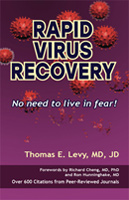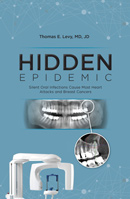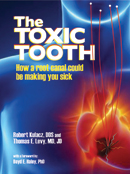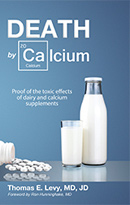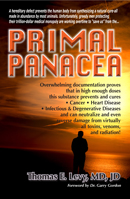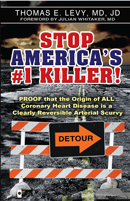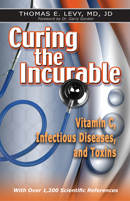Health E-Bytes
Health E-Bytes
Issue No. 6
July, 2003
PULSED INTRAVENOUS VITAMIN C (PIVC) THERAPY
Vitamin C has already been extensively and unequivocally documented to readily cure a wide range of infectious diseases, including many viral syndromes considered incurable even today (Stone, 1972; Smith, 1988, Levy, 2002). In reviewing a great amount of this information, it becomes apparent that for most infectious diseases, especially viral ones, the only clinical failures of vitamin C appear to occur when a large enough amount of vitamin C cannot be effectively delivered to the invading microorganisms.
With this in mind, then, a more effective dosing and/or delivery system of vitamin C to the various tissues of the body should further improve the clinical efficacy of this agent. In cancer, Riordan et al. (1995) demonstrated the likelihood that vitamin C was an effective anti-tumor therapy as long as high enough concentrations of it could be achieved inside the tumor(s). These researchers also concluded that oral vitamin C supplementation was unlikely to produce blood levels of vitamin C high enough to have a direct killing effect on a given tumor. Later, in studying a certain line of cancer cells and the ability of vitamin C to kill those cancer cells, Casciari et al. (2001) elegantly demonstrated this point. They showed that the rapid intravenous infusion of vitamin C as sodium ascorbate in combination with alpha lipoic acid was effective in reaching vitamin C levels that were toxic to the cancer cells. They also showed that a fat soluble analogue of vitamin C, phenyl-ascorbate, was able to kill cancer cells effectively at a dose roughly three times lower than seen with unaltered vitamin C.
All of the conclusions reached by Casciari et al. noted above support the proposed concept that most clinical failures of vitamin C for infections or other medical conditions relate to inadequate delivery. They administered as much as 60,000 mg of vitamin C over an 80-minute period, a very sizable dose and a fairly rapid administration by most standards of current usage. Yet such a large and rapidly administered infusion of vitamin C will not always be clinically effective. This still does not mean that the vitamin C might not be the optimal treatment for a given condition.
At the Colorado Integrative Medical Center (www.coloradomedicalcenter.com) in Denver, CO, we are starting to use a unique form of vitamin C therapy known as pulsed intravenous vitamin C (PIVC) therapy. First and foremost, this therapy utilizes the principle that the more rapidly a given dose of any nutrient or medication is given, the higher the peak blood level of that substance will be. This very rapid delivery of vitamin C was first reported to be both safe and highly effective by Klenner (1971). In acute barbiturate overdose Klenner gave as much as 42,000 mg of vitamin C "by vein as fast as a 20 gauge needle could carry the flow." This dose awoke the patient and began the reversal of the barbiturate toxicity without causing any side effects of note. Klenner safely administered IV push vitamin C on multiple occasions, often on very critically ill patients, with great clinical success and no reported toxicity.
The concept of PIVC is to get acute blood levels of vitamin C as high as possible. By simple diffusion physiology, an acute doubling or tripling of the blood vitamin C levels will temporarily allow an acute doubling or tripling of the amount of vitamin C that normally diffuses into perfused tissues via the gradient that is present at the baseline concentration. The temporary blood levels achieved can be substantial. If Casciari et al. can get a certain high blood level from infusing 60,000 mg of vitamin C over 80 minutes, then an IV push of 20,000 mg of vitamin C over 2 minutes can be expected to temporarily increase the peak blood concentration by 10-fold or more over the rapid intravenous infusion. This amount has already been administered safely on multiple occasions.
A physiological effect of such a rapid administration of vitamin C appears to occasionally induce an acute hypoglycemia. Sylvest (1942) found that a majority of people given intravenous vitamin C showed a clear lowering of blood sugar. This effect is possibly due to a significant reflex release of insulin from the pancreas. Such a conclusion is directly supported by the work of Cheng et al. (1989), who found that vitamin C injected into rats "produced a dose-dependent and marked hypoglycaemic effect after intravenous injection." They also found that the hypoglycemic effect was maximal at five minutes after injection, coinciding with an increase in the plasma insulin concentration. Vitamin C is a very similar molecule to glucose, and a rapid spike of vitamin C released into the blood likely can induce the same reflex insulin spike that is seen in a glucose tolerance test, where a large dose of glucose is given to evaluate how quickly and effectively one can restore glucose levels to normal by inducing insulin release. Clinically, this hypoglycemic effect has been the most notable in patients who are ingesting little food and drink, and in those patients who are generally sickest, as in advanced neurological conditions. In such patients just an infusion of vitamin C can cause hypoglycemia as well, not requiring the rapid IV push. Such patients may need a bolus of 50% glucose to rapidly reverse the low blood sugar, as it has been noted to occur even when the carrier IV fluid is 5% dextrose (sugar) in water. However, the IV push does seem to more reliably cause the hypoglycemic symptoms, which fits with the animal literature cited above.
This vitamin C-induced hypoglycemia should prove to be a very desirable effect clinically, however. Severe hypoglycemia has already been safely and deliberately induced in a protocol that has been in existence for over 70 years now. Known as insulin potentiation therapy (www.iptq.org), intravenous insulin (roughly 20 to 40 units) is given rapidly to induce hypoglycemia. As hypoglycemia becomes manifest, minidoses of cancer chemotherapeutic agents are administered. Such small doses, in the presence of insulin-induced hypoglycemia, appear to be facilitated in their transport across the cell membrane pathways such that the drugs reach killing concentrations inside cancer cells at much lower dosage levels. Traditional chemotherapy can often be given without causing the otherwise inevitable loss of hair seen with the much larger doses.
Vitamin C and glucose actually directly compete with each other for insulin-mediated transport into the various cells of the body (Washko et al., 1991; Cunningham, 1998). Increased intracellular access should prove to be a major leap forward in the effective treatment of most diseases already known to be responsive to vitamin C, and in likely quite a few more diseases that just need more effective dosing of vitamin C to show a positive response. Proprietary protocols being developed at the Colorado Integrative Medical Center are using such "Vitamin C-Enabled Intracellular Nutrition" (VEIN) methodologies.
A side effect associated with high doses of vitamin C, along with other nutrients given intravenously, and sometimes associated with concomitant hyperbaric oxygen therapy, has been noted at our facility. On three occasions patients have complained of bilateral mid-back discomfort. When this has been reported, further intravenous nutrients are discontinued, oral hydration and intravenous hydration are initiated, and oral or intravenous furosemide is given. This has resolved the discomfort in all circumstances. No associated abnormal laboratory findings have been seen to result. It is hypothesized that when the solute load gets high enough in the blood perfusing the kidney, a dehydrating effect is acutely inflicted on the kidney cells, causing the pain/discomfort reflex. Neglected, more serious complications could occur. However, the regimen just outlined takes care of such situations fairly promptly. Furthermore, such a side effect can actually give the health care practitioner a practical point beyond which further intravenous nutrition should not be pushed acutely.
Anecdotally, I have had the occasion to clinically cure a case of acute Lyme disease with three days of intravenous vitamin C therapy. Whether this is readily repeatable, or whether a chronic case of Lyme disease would respond as well remains to be seen. At the Colorado Integrative Medical Center we are now initiating a combination of therapies including those mentioned in this newsletter to see precisely how much success we can have on a regular basis with this particular disease. We are presently accepting new patients at this time who have this condition and are looking for another treatment option.
Contact Information:
Colorado Integrative Medical Center
1260 South Parker Road
Denver, CO 80231
Toll-free: 866-750-2121
FAX: 303-750-4992
Ask for Darren Green, office manager
Bibliography
Casciari, J., N. Riordan, T. Schmidt, X. Meng, J. Jackson, and H. Riordan. (2001) Cytotoxicity of ascorbate, lipoic acid, and other antioxidants in hollow fibre in vitro tumours. British Journal of Cancer 84(11):1544-1550.
Cheng, J., S. Hsieh-Chen, and C. Tsai. (1989) L-Ascorbic acid produces hypoglycaemia and hyperinsulinaemia in anaesthetized rats. The Journal of Pharmacy and Pharmacology 41(5):345-346.
Cunningham, J. (1998) The glucose/insulin system and vitamin C: implications in insulin-dependent diabetes mellitus. Journal of the American College of Nutrition 17(2):105-108.
Klenner, F. (1971) Observations on the dose and administration of ascorbic acid when employed beyond the range of a vitamin in human pathology. Journal of Applied Nutrition 23(3&4):61-88.
Levy, T. (2002) Vitamin C, Infectious Diseases, and Toxins: Curing the Incurable. Philadelphia, PA: Xlibris Corporation. (www.xlibris.com)
Riordan, N., H. Riordan, X. Meng, Y. Li, and J. Jackson. (1995) Intravenous ascorbate as a tumor cytotoxic chemotherapeutic agent. Medical Hypotheses 44(3):207-213.
Smith, L. (1988) The Clinical Experiences of Frederick R. Klenner, M.D.: Clinical Guide to the Use of Vitamin C. Portland, OR: Life Sciences Press.
Stone, I. (1972) The Healing Factor: "Vitamin C" Against Disease. New York, NY: Grosset & Dunlap.
Sylvest, O. (1942) The effect of ascorbic acid on the carbohydrate metabolism. Acta Medica Scandinavica 110:183-196.
Washko, P., D. Rotrosen, and M. Levine. (1991) Ascorbic acid in human neutrophils. The American Journal of Clinical Nutrition 54(6 Suppl):1221S-1227S.
Copyright © 2003 by Thomas E. Levy, M.D., J.D.
All Rights Reserved; Reproduction Permitted only with Acknowledgement and of the Entire Document
Other Issues
Issue No. 1 - October, 2001
Bioterrorisms: Beyond Vaccinations and Antibiotics
Issue No. 2 - November, 2001
Bioterrorism: Beyond Antrhax and Smallpox
Issue No. 3 - January, 2002
Artificial Water Flouridtion: More Than Just Flouride
Issue No. 4 - May, 2002
Some Observations on "Enriched" Food Products
Issue No. 5 - October, 2002
Electrons, Toxins and Disease
Issue No. 7 - December, 2003
Vitamin C and Severe Influenza: a case report
Issue No. 8 - December, 2004
Vitamin C, Pumonary Embolism, and Cali, Colombia
Issue No. 9 - June, 2005
The Many Faces of Vitamin C

